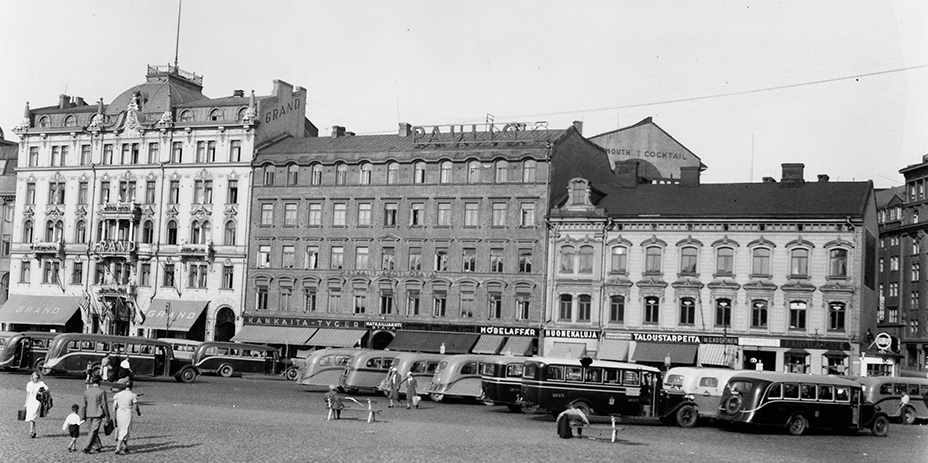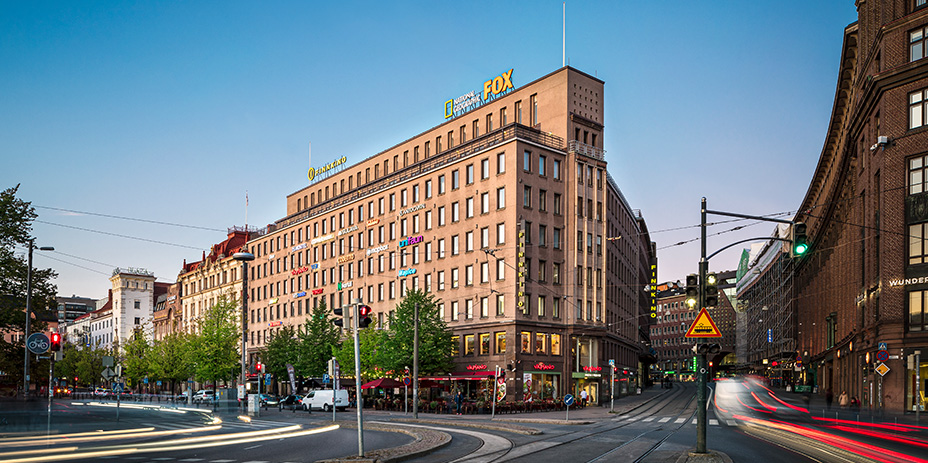
From the Järnefelt family home to Nokia headquarters
The site on Mikonkatu 15 originally housed a three-storey revival-style stone building that was built around 1860. Known as the Resvoy House, the building was home to Aino Järnefelt (Sibelius by marriage) and her family in the 1880s. In 1941, the headquarters of Suomen Gummitehdas, which later became known as Nokia, was built on the site. Today, Mikonlinna is a modern office and commercial property.
Mikonkatu 15 is one of the historically significant buildings in the heart of Helsinki. In the course of its history going back more than 160 years, the building has undergone architectural changes and lived through several twists and turns in the city’s development. Thanks to its location, the building has always been part of Helsinki’s vibrant centre, and various occupants have left their mark on the cityscape at different times.
Resvoy House and Helsinki of the 19th century
A three-storey, revival-style stone building, which was built around 1860, originally stood on Mikonkatu 15, on the site of the current commercial property. The building, known as the Resvoy House, represented the typical Helsinki cityscape of that time, with stone buildings starting to replace wooden buildings. The Resvoy’s House was part of Helsinki’s development in the second half of the 19th century, when the city’s infrastructure began to modernise.
Among the most famous residents of the building in the 1880s was the Järnefelt family, who were active in cultural circles and whose daughter Aino Järnefelt later married composer Jean Sibelius. Aino’s brother Eero Järnefelt is one of Finland’s most famous painters. Thus, the building is associated with some of the great figures of the Finnish culture. During this period, Helsinki boasted a buzzing art scene, which the Resvoy House was part of.

Suomen Gummitehdas and the era of modernisation
The Resvoy House’s story came to a close when the city’s rapid growth and industrialisation created pressure to build new buildings. In 1941, a new nine-storey building designed by architect Walter Jung in the functionalist style popular at the time was built on the site. The building was commissioned by Suomen Gummitehdas, later known as Nokia.
At the time, Suomen Gummitehdas was one of the most significant industrial companies in Finland, and the construction of its headquarters in a prime location in the centre of Helsinki highlighted the company’s position as a driver of economic development. The top floors of the modern building afforded spectacular views over the city’s rooftops.
Development of Mikonkatu and Mikonlinna today
Mikonkatu itself got its name already in 1820, when the Helsinki street plan was drawn up during the reign of the Russian Emperor Alexander I. Running from Esplanade Park to Kaisaniemi Park, the street is named after Grand Duke Mikhail Pavlovich of Russia. The street was partially converted into a pedestrian street in 1992, which strengthened its role as a vibrant hub in Helsinki.
At the beginning of the 2000s, Mikonkatu 15 underwent a major renovation and refurbishment, transforming it into a modern office and commercial property. Today, Mikonlinna is an integral part of the Fennia block, located near the Railway Square in Helsinki’s busiest business district.
The story of Mikonkatu 15 also bears witness to the growth and development of the City of Helsinki. The building has lived through historical transformations, seen the life of major cultural figures and the rise of industrialisation.

